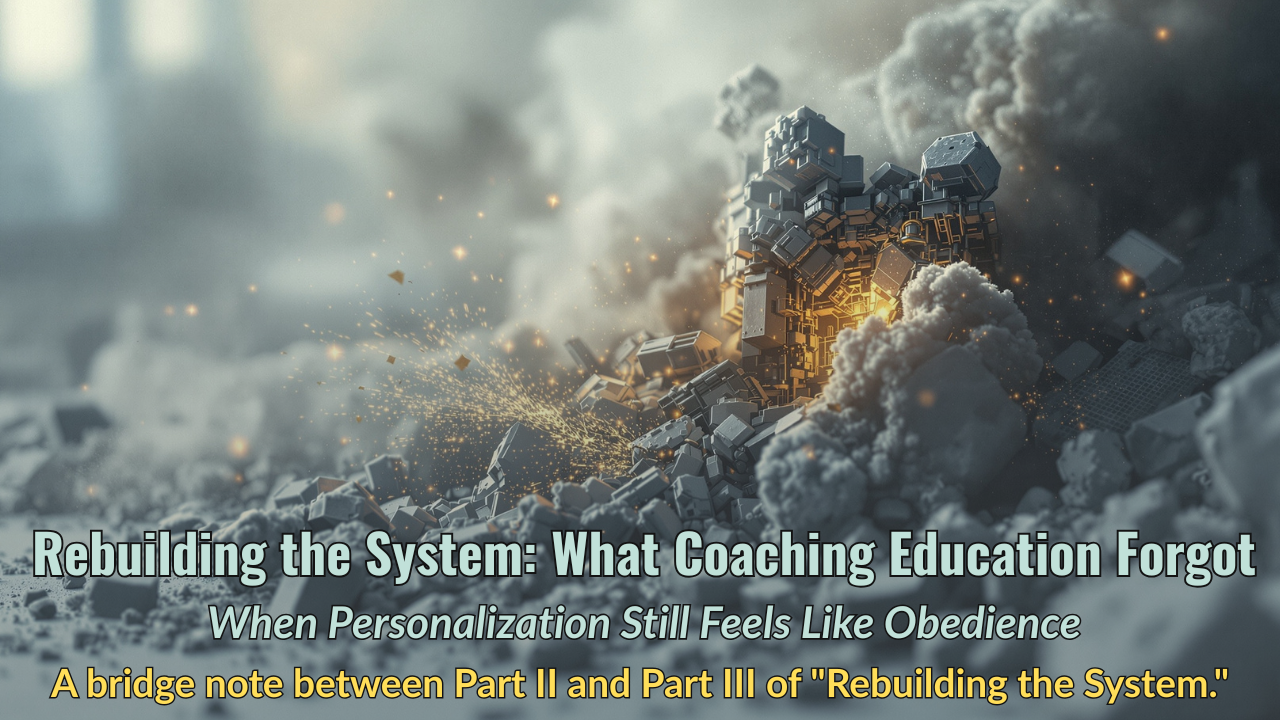When Personalization Still Feels Like Obedience
Nov 11, 2025
A bridge note between Part II and Part III of "Rebuilding the System."
Walk into almost any modern tennis academy and you'll see the evidence of progress. Color-coded progress charts line the walls. Each player has a development plan with their name on it. A mental-skills coach runs workshops in the conference room. It feels enlightened. Organized. Individualized.
Until you look closer.
Every player moves through the same warm-up patterns. Every "individual plan" lists the same six goals, just rearranged. Every coach still gives feedback in the same tone, same rhythm, same sequence of drills. The names changed. The obedience didn't.
That's what personalized compliance looks like—individualized surface, identical structure.
When Customization Becomes Control
The logic behind personalized programs is sound. We want players to feel seen. But the structure underneath still defines the behavior on top. When compliance culture meets customization, we just rebrand control as care.
It's the same pattern we see in education, corporate training, and even tech: "Personal dashboards" that track standardized data. "Individual development plans" that all follow the same milestones. "Choice menus" that only include pre-approved options.
The illusion of freedom becomes the mechanism of control.
That's why every attempt to modernize a compliance-based model ends up strengthening it. A new language of "personalization" is poured into the same mold—designed for obedience, not agency. The result: every player looks busy, but few look alive.
How It Happens in Coaching
Take a common pattern. A coach gives every player a "custom" development plan at the start of the semester. It lists goals like consistency, point construction, decision-making under pressure. The player checks in monthly to review progress. Boxes get ticked. Words get repeated. But nothing truly new emerges because the plan dictates the learning rather than the learner dictating the plan.
That's not personalization. That's choreography.
A genuinely individualized plan starts with observation, not template. It asks, How does this player think? How do they make sense of feedback? What kind of attention wakes them up? Then it adapts—not once, but continuously. That's not customization. That's Communiplasticity in miniature: communication bending to the receiver instead of the sender.
The Real Test
Here's how you can tell the difference as a parent watching from the fence:
- If your child can recite the plan but can't explain why each piece matters, they're following a script.
- If their "individual sessions" feel like group practice in disguise, you're seeing personalization as theater.
- If the coach changes tone, tempo, or language based on how your child responds—if the message seems to fit—then you're seeing real adaptation.
True personalization feels messy. It requires time, reflection, and trust. It can't be scheduled in fifteen-minute slots or color-coded on a chart. It happens in the in-between moments—when a coach pauses to ask, "What were you thinking there?" and listens long enough to hear the real answer.
Why It Matters
The old factory model rewarded sameness because sameness was efficient. Now we've painted individuality on top of it like camouflage. Personalization without agency is just obedience with a friendlier face.
If we want learners who can think, we have to let them influence the structure itself. That means smaller feedback loops, more dialogue, and communication that changes shape based on who's receiving it.
Until that happens, "personalized learning" will keep producing players who look unique but think identically.
Next: Thursday 13 Nov — The Hidden Cost of Efficiency
Why the most dangerous word in coaching isn't "compliance." It's "efficient."
Never Miss a Moment
Join the mailing list to ensure you stay up to date on all things real.
I hate SPAM too. I'll never sell your information.
